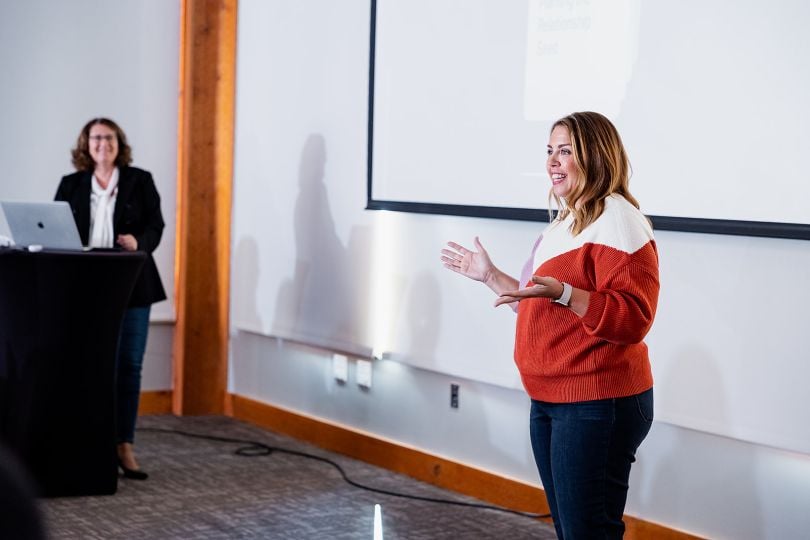Once the embers cool and animals come back to roam after a wildfire, scientists measure and study the resilience of that ecosystem — or rather, how quickly the forest can return to a stable environment.
As climate change continues, resiliency is one of the most important traits that an ecosystem can have. Whether or not an environment can bounce back and adapt to an abrupt change tells scientists how the area will be impacted by things like natural disasters. The more adaptable an ecosystem is to change, the more likely it is to survive.
While change at work is generally not as impactful as a natural disaster, resilience and adaptability are often shared attributes amongst employees and leaders who move through change — or guide others through it — the most successfully. Built In spoke with two leaders about how they stayed adaptable through big moments of change, and how they helped their team be more resilient.

10Pearls is an end-to-end digital partner. 10Pearls helps businesses create digital products using expertise in product management, UI/UX, cloud architecture, software development, data science, cybersecurity and quality assurance.
10Pearls acquired Inspirant Group in early 2023. How has the change over the last year impacted you and your team?
Our company was a consulting startup that had reached the five-year mark with successful projects, great team members and a solid strategic direction — but to help us achieve continued success and to fuel growth opportunities, our founders made the decision to be acquired.
After the initial shock wore off, I had lots of questions. Who was this new company? How does my team fit within the larger corporate initiatives? How do I continue to work while our strategic direction is being redefined? Does this new company and direction still fit “me”? I had fundamental questions about whether I wanted to be part of the new company. I had chosen to work for my initial company, but they had chosen who I was working for today.
Change is deeply personal, and everyone experiences it differently. As a change management consultant who thought she could handle change with the best of them, going through this has become an experience that informs the change management approaches I use with clients today.
“Change is deeply personal, and everyone experiences it differently.”
Being a leader made the journey even more difficult. It can be challenging to try and remain positive, supportive and engaged with your team when you are struggling through the change yourself.
How have the leaders at 10Pearls kept everyone engaged and motivated?
Our business has always benefited from a culture of transparency, but this becomes more important during change. Our team members needed to be able to ask difficult questions, and our leaders needed to be honest in their answers.
In order to achieve this, our leaders established change forums where team members could pose change-related questions, which were publicly answered. During team meetings, we included change-specific topics and shared new information, had questions answered in real time and met key individuals from our new company.
Our leadership team recognized that change is highly personal. To ensure team members felt heard on an individual level, leaders conducted one-on-one meetings, allowing each person the opportunity to discuss questions, issues or concerns.
“Transparency becomes more important during change. Team members need to be able to ask difficult questions, and leaders need to be honest in their answers.”
Lastly, our new company welcomed feedback from the beginning and worked closely with our leadership team. They acknowledged their part in helping our team members go through a seamless transition. Throughout the transition, they invited staff to headquarters, hosted networking events and opened their doors — as well as their calendars — to help make it easier to meet new people and form new relationships.
How have the teams navigated new ways of working? How have leaders helped guide this?
Our daily routine didn’t change during the acquisition process. For our team, establishing new connections with our new employer had the biggest influence. Our founders ensured everyone was introduced virtually to key personnel at the new company, which helped kick-start the transition process.
We’ve moved into a discovery phase, where we’re exchanging best practices. We’re also learning about their new procedures while they're learning about the capabilities we bring to the table. I appreciated how my leader embraced this process and made time to visit headquarters so she could network. Our team can collaborate with various virtual business units, participate in joint sales meetings and join operational calls as a result of this partnership. As we forge relationships, all of these efforts enable our team to become more visible within the new organization.
Founded in 2021, Avaneer Health is a member-based network built on secure technology to ensure privacy and reduce the costs of data exchange. Avaneer Health helps customers through transparency and security to make healthcare decisions easier.
How has Avaneer Health changed over the past year? How has this affected you and your team?
Throughout this year, we’ve made changes to our teams in order to more effectively align with Avaneer’s mission to improve interoperability in the healthcare industry. For our teams, this meant a greater focus on product-based initiatives, a reduction of inter-team dependencies and a deeper culture of quick and iterative experimentation.
For myself, this year started with developing enhancements to our identity matching and permissioned data-sharing solutions. The year then transitioned into leading and growing a team dedicated to that cause. Now, I have the privilege of working in a team that enables payers and providers to utilize these solutions and our network to accelerate the realization of business their value.
How has leadership at Avaneer Health helped you stay engaged and motivated during this period of change?
Tactically, our leadership’s identification of industry opportunities and transparent communication of these insights reinforces my motivation and confidence in our organization.
Culturally, the constant demonstration that we can be considerate, strategic, fun and professional is a natural reminder for me to share the same values and lead by example.
These traits also create a highly engaging environment for our teams.
“Culturally, the constant demonstration that we can be considerate, strategic, fun and professional creates a highly engaging environment.”
Our leadership continually nurtures this culture by ensuring our teams understand where our initiatives come from and how our solutions, like our Insurance Coverage Alignment, directly correlate to value for our stakeholders. Equipped with this context, our teams are better prepared to think critically about developing creative and sustainable solutions.
How has your direct leader and the broader leadership at Avaneer helped you adjust to new ways of working?
My leader, and all leaders at Avaneer, promote and actively support a culture of experimentation. When there’s a new change or a shift in the way we work, it’s always open for feedback and adjustments. This foundation easily creates an environment where ideas are approached with an open mind.
On top of that, an easy way to adjust to a new method of working is by contributing to the shaping of the change. Thoughtful team collaboration and team input can lend itself to a greater ease of adoption. This applies to both process change and technical design. How we organize our work and how Avaneer provides support to our clients are just a few examples of where leadership seeks input and contributions on how we can improve.









